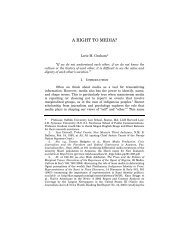The Right to Dignity Rex D. Glensy - Columbia Law School
The Right to Dignity Rex D. Glensy - Columbia Law School
The Right to Dignity Rex D. Glensy - Columbia Law School
You also want an ePaper? Increase the reach of your titles
YUMPU automatically turns print PDFs into web optimized ePapers that Google loves.
2011] <strong>The</strong> <strong>Right</strong> <strong>to</strong> <strong>Dignity</strong> 121<br />
intervene on behalf of) human dignity.” 254 In practice, what this<br />
means is that one arm of the state will take it upon itself <strong>to</strong> make<br />
sure that another arm of the state is not infringing upon those rights<br />
<strong>to</strong> which individuals are deemed entitled. In the United States, this is<br />
how jurisprudence pertaining <strong>to</strong> constitutional rights has developed,<br />
and it applies across the board <strong>to</strong> such mainstays of American rights<br />
as equal protection, due process, free speech, and cruel and unusual<br />
punishment. A negative rights approach <strong>to</strong> the right <strong>to</strong> dignity would<br />
add dignitary interests <strong>to</strong> those rights that the state would be unable<br />
<strong>to</strong> impinge. <strong>The</strong> right <strong>to</strong> dignity would become a de fac<strong>to</strong> background<br />
norm and an independent consideration <strong>to</strong> contend with when a<br />
claimant alleges a violation that would impact human dignity.<br />
In speaking of human dignity, Eleanor Roosevelt remarked<br />
that it reflected the notion that “every human being is worthy of<br />
respect” and thus explained “why human beings have rights <strong>to</strong> begin<br />
with.” 255 This means that “human dignity or a similar understanding<br />
of universal humanity underlies all human rights.” 256 In other words,<br />
the negative rights approach is based on the understanding that<br />
human dignity is the source of human rights and hence is anterior or<br />
above the state and <strong>to</strong> which it does not belong conceptually. What<br />
follows, consequently, is that in the right <strong>to</strong> dignity is embodied the<br />
notion that it is beyond the reach of the state. In this guise, the right<br />
<strong>to</strong> dignity becomes a metric against which other rights can be<br />
measured. Because, as an ideal, dignity is “clearly accepted as<br />
universal,” 257 it is reflected in this role as a standard bearer, lying just<br />
below the surface of enumerated rights.<br />
<strong>The</strong> main idea behind incorporating the right <strong>to</strong> dignity as a<br />
background norm is the notion that human dignity itself is a quality<br />
closely associated with a liberal concept of governance. 258 Indeed,<br />
dignity has been described as one of “the cardinal principles for which<br />
the [United States] Constitution stands.” 259 In other words, it could be<br />
254. Beth Simmons, Civil <strong>Right</strong>s in International <strong>Law</strong>: Compliance with<br />
Aspects of the “International Bill of <strong>Right</strong>s”, 16 Ind. J. Global Legal Stud. 437, 440<br />
(2009).<br />
255. Mary Ann Glendon, A World Made New: Eleanor Roosevelt and the<br />
Universal Declaration of Human <strong>Right</strong>s 146 (2001).<br />
256. Donna Greschner, <strong>The</strong> Purpose of Canadian Equality <strong>Right</strong>s, 6 Rev.<br />
Const. Stud. 290, 321 (2002).<br />
257. Schachter, supra note 14, at 849.<br />
258. See Daniel Bodansky, Is <strong>The</strong>re an International Environmental<br />
Constitution?, 16 Ind. J. Global Legal Stud. 565, 569 (2009).<br />
259. Trop v. Dulles, 356 U.S. 86, 100–02 (1958) (noting that stripping an<br />
individual of his citizenship was “offensive” <strong>to</strong> this principle); see also Goodman,















